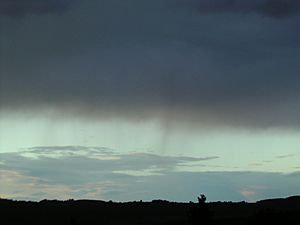Virga facts for kids
In the world of meteorology, which is the study of weather, virga is a special kind of precipitation. Precipitation means any form of water that falls from clouds, like rain, snow, or hail. What makes virga unique is that it falls from a cloud but never actually touches the ground. Instead, it either evaporates (turns into a gas) or sublimes (turns directly from ice into a gas) high up in the air.
What is Virga?
Virga looks like streaks or wisps hanging down from clouds. It often appears like rain that just disappears before it reaches you. This happens because the air below the cloud is very dry or very warm. As the raindrops or ice crystals fall, they quickly turn back into water vapor.
Why Does Virga Happen?
Virga is common in places with low humidity and high temperatures. Humidity is how much moisture is in the air. When the air is very dry, it can absorb a lot of water. If the air is also warm, it helps water evaporate even faster. So, as the rain or snow falls, the dry, warm air acts like a giant sponge, soaking up all the moisture before it can hit the ground.
Where Can You See Virga?
You can often see virga in deserts and temperate climates. These are areas that can have very dry air. In North America, it is often seen in the Western United States and the Canadian Prairies. It is also common in the Middle East and North Africa. Seeing virga can be a sign that rain is falling, but it won't reach you!
See also
 In Spanish: Virga (meteorología) para niños
In Spanish: Virga (meteorología) para niños


